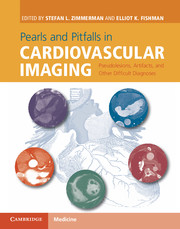 Pearls and Pitfalls in Cardiovascular Imaging
Pearls and Pitfalls in Cardiovascular Imaging from Section 3 - Anatomic variants and congenital lesions
Published online by Cambridge University Press: 05 June 2015
Imaging description
Unroofed coronary sinus is a communication between the coronary sinus and left atrium. The result is a left-to-right shunt that allows flow of oxygenated blood from the left atrium into the coronary sinus. In the normal situation, the coronary sinus courses inferior to the undersurface of the left atrium in the left atrioventricular groove, emptying into the right atrium. In unroofed coronary sinus there is a variably sized communication between the two structures (Figure 24.1). In partial unroofing, a single or several small orifices are seen. In complete unroofing, there is total absence of the tissue separating the left atrium and coronary sinus. At crosssectional imaging, defects are optimally visualized in a shortaxis plane parallel to the atrioventricular groove (Figure 24.2). Associated signs include enlargement of the right atrium and right ventricle due to shunting, which can be quantified using phase-contrast MRI. In the case of small restrictive defects, turbulent flow jets may be visualized in the left atrium on cardiac MRI.
Importance
Unroofed coronary sinus is a rare cause for left-to-right shunt. It may be challenging to make the diagnosis on transthoracic echocardiography due to limited imaging windows, resulting in referral of patients to cardiac CT or MRI to evaluate for occult shunt. Diagnosis is important due to potential for transient right-to-left shunting that can result in systemic emboli or brain abscess.
Typical clinical scenario
Unroofed coronary sinus is a rare disorder that is the least common type of atrial septal defect, representing less than 1% of these anomalies. There is a frequent association with left-sided superior vena cava, which is seen in approximately 63–75% of cases. Many patients will have additional congenital cardiac defects.
Differential diagnosis
Unroofed coronary sinus should be distinguished from other types of potentially difficult to diagnose left-to-right shunts, such as sinus venosus atrial septal defects and partial anomalous pulmonary venous return.
To save this book to your Kindle, first ensure [email protected] is added to your Approved Personal Document E-mail List under your Personal Document Settings on the Manage Your Content and Devices page of your Amazon account. Then enter the ‘name’ part of your Kindle email address below. Find out more about saving to your Kindle.
Note you can select to save to either the @free.kindle.com or @kindle.com variations. ‘@free.kindle.com’ emails are free but can only be saved to your device when it is connected to wi-fi. ‘@kindle.com’ emails can be delivered even when you are not connected to wi-fi, but note that service fees apply.
Find out more about the Kindle Personal Document Service.
To save content items to your account, please confirm that you agree to abide by our usage policies. If this is the first time you use this feature, you will be asked to authorise Cambridge Core to connect with your account. Find out more about saving content to Dropbox.
To save content items to your account, please confirm that you agree to abide by our usage policies. If this is the first time you use this feature, you will be asked to authorise Cambridge Core to connect with your account. Find out more about saving content to Google Drive.